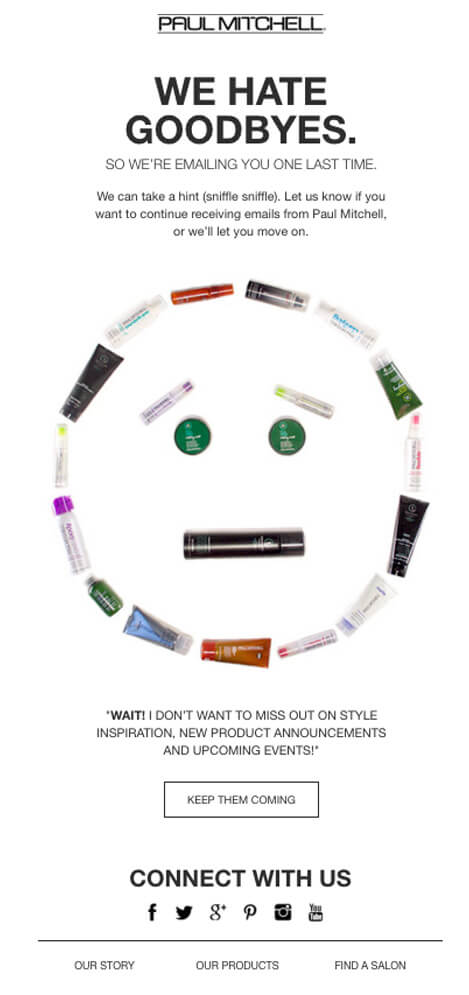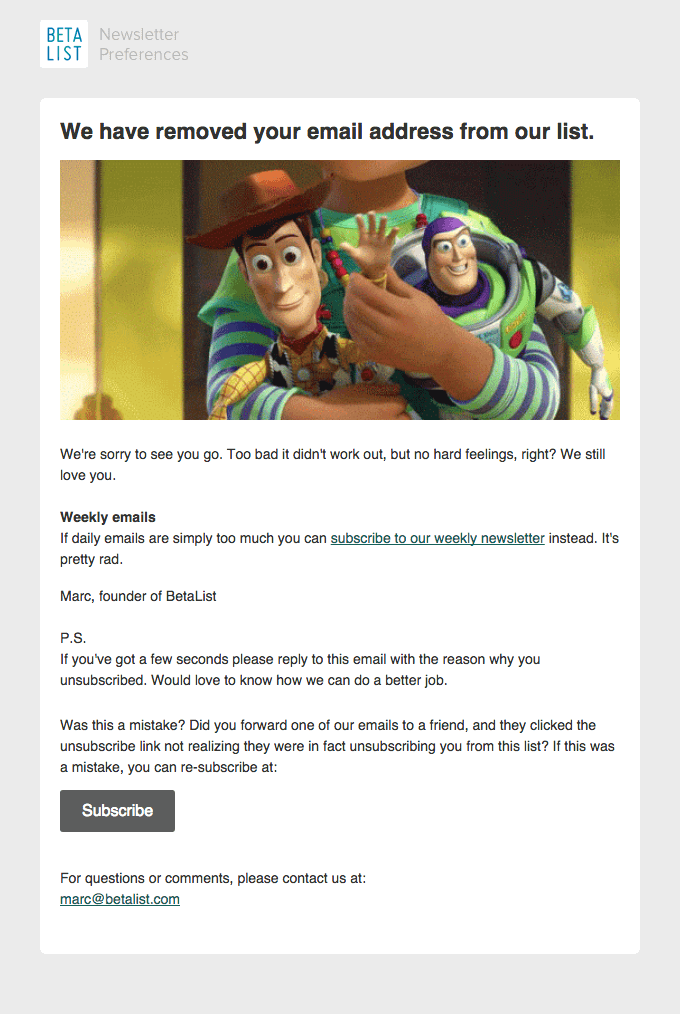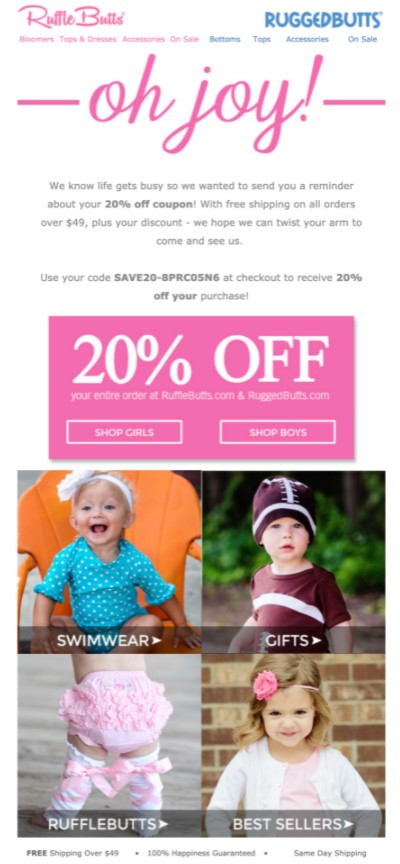Learn all about using win-back emails for ecommerce.
Gone are the days when email was used strictly as a form of communication. Nowadays, it is increasingly being deployed as a marketing tactic for brands to engage with their customers. Win-back emails are no exception and are an essential tool that can be effectively utilized by brands to drive conversions and win back their once-loyal customers.
What are ecommerce winback emails?
Win-back emails are a type of email marketing campaign that you can use to re-engage your audience or customers and win them back from the competition. The benefits of using a win-back email include increased purchase rates, increased conversion rates with existing customers, improved customer retention rates and increased sales opportunities.
Simply put, win-back emails have three main functions: to remind customers of your business and the great deals they’ve missed out on, to offer new promotions, and to ask for feedback. These emails are a great tool for salespeople who want to reconnect with customers they’ve lost in a sale but have not lost the hope of converting them into a customer.
In this article, we’ll explore what win-back emails are, why they’re important and the different types you should use at different points in your sales process.
Why are winback emails important in ecommerce?
Why should brands even bother to create a win-back email campaign?
Every year, an average email list loses 20-25% of its active contacts. Repeat customers (who’ve done more than 2 purchases with your brand) have a 60-70% chance of buying again compared to the average of 1-3% for converting a new customer.
Retaining a customer works much better for a brand than acquiring a new one. A well-crafted win-back email campaign is one of the simplest ways to increase customer retention and reduce churn.
In a study conducted by ReturnPath, an analysis of 33 various win-back email campaigns by different eCommerce stores was done to observe how effective they were in turning inactive subscribers into active customers.
The results showed that after receiving their first win-back email, 45% of the email recipients read the subsequent email from the brand after receiving the first email. 75% of these re-engaged subscribers had read the message within 89 days (after the first win-back email), and the other 25% were still opening emails 300 days after receiving the first win-back email.
By crafting an effective win-back email, you can remind customers why they subscribed to your list and convince them to buy from you again. It’s a great way to rekindle the customer’s relationship with your brand and get them back on board.
Here’s why win-back emails work so well for eCommerce stores:
- Win-back emails help you build customer loyalty. Loyal customers are willing to pay more for your products or services.
- They increase the likelihood that an email recipient will purchase from your company again.
- You can increase the lifetime value of customers by encouraging an existing customer to return to your brands and make a purchase. Moreover, you’ll be cutting down on the expense needed to acquire new customers.
- Win-back emails usually result in a positive response and give the customer a chance to give feedback about their last purchase experience.
- You can use win-back emails as a way to offer promotions or discounts on similar products you offer to loyal customers who have purchased from you within a specified time period.
- These emails are less expensive to send than other campaigns, which means they often deliver a higher ROI.
Sending win-back emails at the appropriate time is the key to converting your once lost customers into loyal buyers. Some of the best times are:
- If a customer goes more than 24 hours without making a purchase
- If you make changes to your product or service
- When your former customer logs into their account
Types of win-back emails for ecommerce
Win back emails are a great way to build engagement with your customers and increase your customer base through targeting long standing customers who have had a lapse in their relationship with you. The email should strike up a conversation and be welcoming in order to make them feel valued again.
Let’s take a look at some types of win-back emails, and how you can use them for your business!
1. The “welcome-back” email
The “hello” win-back email aims to achieve one goal: remind people that you exist. There could be any reason why your customer disconnected with the brand, and a simple “hello” email will get some people to start interacting with your messages again.
The welcome back email should accomplish 4 goals:
- Jog your customer’s memory about why they became your customer in the first place.
- Remind them of the awesome benefits your product provides.
- Induce a feeling of recognition and appreciation.
- Keep your brand fresh in your customer’s mind.
Your welcome back email should be crisp and simple. Inactive customers don’t wish to read an email filled with copy, therefore your message should be to the point.
Remind customers of what made them try your brand in the first place. Use this opportunity to provide that little nudge as a reminder of all the benefits you provide.
And finally, make it easy for your customer to come back with a low-friction call-to-action that subtly and politely asks, instead of being demanding.
2. The incentive email
Your welcome back email may be good enough to get you back into the limelight, but not compelling enough for them to purchase from you. This is where incentives come in.
If your customer doesn’t react to your reminder email, an offer of a discount on your product, or some kind of reward may help get them back.
There are plenty of incentives you can offer to win back a lost customer, including:
- A timed discount code
- A bonus gift
- Free upgrades
- Extra reward points
- Free and fast shipping
- Complementary products
- Free samples
- Sweepstakes and prizes
- A free consultation
Here’s how Ticketfly offers a related incentive (like a 3-month Pandora music subscription) to get their customer to respond. They also utilize this opportunity to inform the reader about their latest developments.

3. The feedback email
Here’s an irrefutable fact: people just love giving opinions!
Therefore, a feedback email works well to convince inactive customers to come back and engage with the brand.
There could be any reason why a past customer stopped interacting with your brand. It could be bad customer service or a sloppy user experience. Or maybe they don’t find the best deals at your store anymore.
Whatever the reason, a feedback email might be the one thing that gets the customer to share with you why they stopped engaging with your brand. It also makes them believe that their satisfaction is your top priority.
Even if you can’t convince them to purchase from you, asking people for their perspective is a great way to get them to interact with your email. On the plus side, the feedback you receive gives insight on how you can improve your emails, your store’s eCommerce experience, and your customer service.
Here’s a good welcome back email from Anthropologie that works empathy into its email copy by mentioning that they care about their customer’s experience. The brand gives their customers a reason to respond to their request of filling out a feedback survey by offering them an incentive, like a discount code.

4. The Goodbye email
The goodbye email is your final effort to convince a disengaged customer who has been unresponsive to your earlier win-back emails to come back.
This email would inform the subscriber that if they respond to the email by clicking the CTA to stay on your mailing list, you’ll eliminate them from the mailing list in X days (X is recommended to be 30 days).
However, if they ignore this email, you move on. But if they choose to stay on your list, you can run another email campaign in the future to try to win them back again.
This kind of re-permission win-back email serves two purposes:
- It motivates unresponsive people to engage by leveraging fear. For some customers, the fear of losing something is more powerful than the chance to gain something.
- It rids your email list of inactive subscribers, which in turn reduces your email bounce backs and improves the email deliverability rate.
For instance, check out this playful email from Paul Mitchell informing the customer that they’ll be removed from the brand’s mailing list soon. The email does a great job of reminding their customers of the benefits they’ll lose out on, and finally, get them to click the CTA to “keep them coming.”

5. The Unsubscribe email
An unsubscribe email is meant to recapture your customer’s attention if they’re still doubtful about their subscription. It makes your unsubscribe message the last chance you can give to your disengaged customer.
Use the unsubscribe email to simply inform your customers that you’ll be removing them from your email list (you could even mention a specific time frame such as, “within the next 30 days”).
An unsubscribe doesn’t always imply that a customer never wants to hear from your brand again. They might not be finding your emails relevant right now. Sometimes customers decide they want to be back on your email list after they’ve clicked “unsubscribe.”
Therefore, in the goodbye email, give your customers the option to subscribe back, because ultimately your goal is to bring them back.
However, make sure your unsubscribe email doesn’t feel cold or impersonal. That’ll just reinforce the customer’s decision to leave. Provide great user service even after they unsubscribe and they’ll be more likely to return to you in the future.
Check out this unsubscribe email by BetaList. BetaList believes that there are a lot of reasons a customer might unsubscribe. Therefore, it includes a CTA to resubscribe…just in case they unsubscribe by mistake. It also provides an option of subscribing to a low-frequency email list, just in case email frequency was one of the reasons for the customer to opt-out.

10 examples of irresistible win-back email campaigns
1. Birchbox
Birchbox, a beauty subscription business, works a sweet deal in its win-back email. They understand that incentives don’t always have to be a discount. However, they can offer something that is a must-have for most make-up aficionados: a Beautyblender. It also offers a free cleanser (and saving 20 bucks), something that every person needs.

2. Penguin Random House
Penguin Random House – a publishing company used a cheeky “u up?” email subject line to catch the attention of its subscribers. The rest of the email is fun to read and plays on the idea of a text message, basically like a conversation you’d do with a friend. Additionally, the email displays its featured blog content and highlights 21 of its books. This is an excellent win-back strategy: use content creatively without including providing a discount.

3. Shhhowercap
Shhhowercap’s win-back email uses some visually stunning imagery of its main products coupled with various patterns to highlight the offer. Although the brand offers a 20% discount, what truly makes this email stand out is how it communicates the benefits of its products in the email copy. It also nudges the reader to check out their Instagram account, which is a good way to get recipients to follow the brand on social media.

4. Girlfriend
Girlfriend, a women’s activewear brand starts with a simple and straightforward subject line: “We miss you. Here’s $20.” This immediately tells the reader that there is an incentive on the table, but it also comes with a time cap, making them want to act on the offer almost immediately.

5. RuffleButts
RuffleButts, a children’s apparel brand, leads on with an incentive in their win-back email. It reminds its customers that they get to have 20% off their next purchase along with free shipping if they shop with the brand again in this email. They also make it easy for customers to return to their online store again by highlighting two CTAs: one for the boys’ collection and the other for the girls’.

6. Tula
Skincare brand Tula does a lot of things right with their win-back email. The Subject line “We never do this but we miss you” gives a humane touch to the email. The content leads with a 15% off discount, ensuring the recipient that this is an offer they rarely hand out. They also highlight customer favorites along with social proof to make it easy for the reader to re-familiarize themselves with the brand’s products without having to visit the website.

7. Warby Parker
Warby Parker, an online prescription glasses store, uses a social proof approach in their win-back emails by filling their copy with tweets from their satisfied customers. The brand leverages these Twitter testimonials as social proof of their high-quality products and services that rival any competitors.

8. Glossier
Glossier, a beauty brand, approaches its win-back email differently. Instead of offering a discount, they reward customers with a free gift alongside their purchase. And they make sure you know it right away by putting it in the subject line. Moreover, the email has a minimalistic look and feel: displaying just a product image and a straightforward CTA, which fits with their brand image.

9. LastObject
LastObject uses its win-back email as an opportunity to remind its subscribers what their brand is all about and what they have to offer right now. The email starts off with two articles from their blog on how to lead a zero-waste, sustainable lifestyle. These manage to immediately remind the reader of the brand’s core brand values: sustainability, eco-friendliness, and activism.

![]()
Next, they give you a glimpse of their expanding product range. Well-known for its reusable LastSwab, the brand knows that most likely the subscribers are not even aware of their new innovations.

Looking for more examples on the different types of win-back emails you can use for your ecommerce business? Subscribe to our blog here.
Conclusion
Getting disengaged subscribers back on board is not an easy task.
It takes a good amount of creativity and perseverance, and even then, it doesn’t guarantee that you’ll be able to win over everyone. In fact, this process helps you hone your email marketing strategy and enable you to figure out when to double down and when to let go.
However, if you arm yourself with the right content, the right tactics, and the right timing, you can prevent a lot of potential customers from moving on from your brand and even increase your sales.
Exploring the ideal email marketing flows to win-back customers? Sign up for a demo on RetainIQ today.

